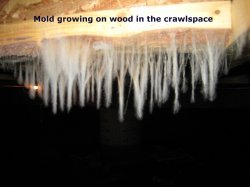Question: If I want to evaluate mold contamination in a building, should I use air sampling of molds or ergosterol in dust?
- Air sampling For Mold
There are 2 methods currently used for sampling for airborne spores. These are air sampling for total fungal spore count (also referred to as nonviable analysis) and air sampling for culturable airborne fungal propagules (commonly referred to as viable analysis). The data obtained by the nonviable analysis are number of spores (or fungal elements if you include other fungal structures) per cubic meter of air. Viable analysis gives colony forming units (CFU) per cubic meter of air. Each of these 2 methods has it’s advantages and disadvantages. For example since non-viable spore analysis depends on the morphology and sizes of spores alone, identification is limited to only a few groups of fungi that have spores with unique characteristic. A vast majority of spores are reported as unidentified since it’s difficult to tell which group of fungi produced them.
The major advantage of nonviable analysis is that since the analysis does not depend on the viability of the spores, all spores present in the sample can be counted whether they are dead or alive. This brings us to the major disadvantage of analysis. If 95% of fungal structures contaminating the air were dead, this method would detected only 5% of the contamination.
The advantage of culturable sampling is that the recovered molds could be identified to species level. This is important because some important characteristics such as production of mycotoxins or pathogenicity are species (and sometimes strain) specific.
Given the advantages and disadvantages of the 2 air sampling methods, an investigator has to decide which method to use. In some cases, using a combination of the 2 methods is recommended.
- Dust Sampling For Ergosterol
Ergosterol is the major sterol in the cell membranes of fungi (yeasts and mold). It’s present in mycelia, spores, and vegetative cells. There is a strong correlation between ergosterol content and fungal dry mass. Ergosterol content has, therefore, been widely used as an estimate of fungal biomass in various environments, such as soil and aquatic systems. Ergosterol measurements have been proposed as a new method for determination of total fungal biomass in investigations of indoor environments. One limitation about this method is that the amount of ergosterol in fungal tissue is not constant and varies with fungal species, age of the culture, developmental stage (growth phase, hyphal formation, and sporulation), and growth conditions (growth media, pH, and temperature). Another limitation is that ergosterol measurements cannot be used to determine the species present in the dust sample since it’s not genera or species specific. The method is currently not widely used and very few commercial laboratories have the capability to analyze for ergosterol in dust.
A Useful Ergosterol Reference
ANNA-LIISA PASANEN, KATI YLI-PIETILÄ , PERTTI PASANEN, PENTTI KALLIOKOSKI, AND JUHANI TARHANEN (1999). Ergosterol Content in Various Fungal Species and Biocontaminated Building Materials. APPLIED AND ENVIRONMENTAL MICROBIOLOGY, Vol. 65, No. 1: 138–142.

